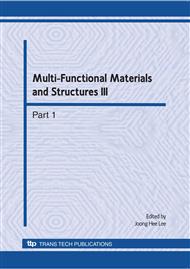p.959
p.963
p.967
p.971
p.975
p.979
p.983
p.987
p.991
Evaluation of the Preparation and Biocompatibility of Poly(vinyl Alcohol)(PVA)/Chitosan Composite Electrospun Membranes
Abstract:
Electrospinning has been used in a wide variety of applications, such as tissue engineering, filtration and biomaterial scaffolds for vascular grafts or wound dressings. Recently, wound dressings have become more important in human life. They must have the superior biocompatibility, water absorption, water vapor permeation and antibacterial ability. Chitosan has been employed in clinical applications and exhibits excellent biocompatibility, biodegradation and bacteriostasis. In this investigation OR study, experiments were performed on a series of poly (vinyl alcohol) (PVA)/Chitosan (CS) fiber membranes at various blend ratios and electric fields to evaluate their spinnability. The morphology, diameter and structure of electrospun nanofibers were examined by scanning electron microscopy (SEM). When PVA/Chitosan=80:20 and electric field=0.67 kV/cm, the spinnability of electrospun membrane was good. IR spectra demonstrated strong intermolecular hydrogen bonds between the molecules of Chitosan and PVA. Furthermore, cell cultures demonstrate that both PAV and chitosan have good biocompatibility and are non-toxic.
Info:
Periodical:
Pages:
975-978
Citation:
Online since:
August 2010
Price:
Сopyright:
© 2010 Trans Tech Publications Ltd. All Rights Reserved
Share:
Citation:


